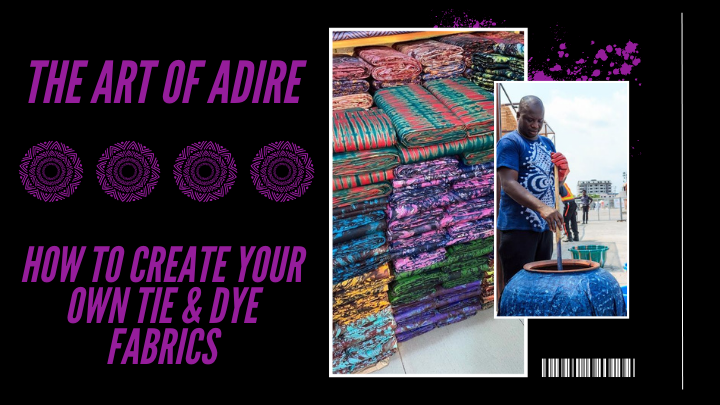The Art of Adire
Adire, the traditional African art of tie and dye, is a vibrant and creative craft that has been passed down through generations in Nigeria, particularly among the Yoruba people. This stunning technique involves handcrafting intricate patterns on fabric using different tying and dyeing methods. Whether you're a beginner or looking to expand your skills, this hands-on guide will walk you through the process of creating your own Adire fabric, offering tips on patterns, dyeing techniques, and fabric preparation.
Step 1: Gather Your Materials
Before you dive into the world of Adire, make sure you have all the necessary tools and materials ready. Here’s what you’ll need:
- Fabric: The best fabric for Adire is usually cotton, as it absorbs dye well. However, you can experiment with other natural fabrics like linen or silk.
- Dye: You can use either natural dyes (such as indigo, which is traditional for Adire) or fabric dye from a craft store. Make sure the dye you choose is suitable for your fabric.
- Rubber Bands or String: These are used for tying the fabric to create different patterns. The tighter you tie, the more defined the design will be.
- Pots and Buckets: For dyeing, you’ll need containers to hold the dye solution.
- Protective Gloves: To protect your hands from the dye.
- Plastic or Plastic Sheets: These are useful for covering your work surface and preventing stains.
- Water and Mild Soap: To rinse the fabric and clean your work area.
- Pins (optional): For creating more complex designs by securing the fabric in specific areas.
Step 2: Prepare Your Fabric
Proper fabric preparation is essential for ensuring your Adire design takes well to the dye. Here's how to get your fabric ready:
- Wash the Fabric: Before dyeing, wash your fabric with mild soap to remove any dirt, oils, or starch that may prevent the dye from absorbing evenly. Avoid using fabric softener, as this can create a barrier for the dye.
- Dry the Fabric: After washing, allow your fabric to dry completely. It's important not to dye wet fabric, as this can cause uneven dyeing.
- Iron (Optional): If you want to smooth the fabric for easier tying, iron it out to remove wrinkles.
Step 3: Select and Create Your Patterns
One of the joys of Adire is the creativity involved in designing your fabric patterns. The beauty of Adire lies in its diversity of designs, which range from simple geometric shapes to complex, intricate motifs. Here are a few common Adire patterns to try:
- Spiral: To create a spiral pattern, start by pinching the fabric at the center and twisting it tightly. Secure the twisted fabric with rubber bands in a spiral formation.
- Geometric Shapes: You can create triangular, square, or rectangular shapes by folding and securing the fabric in specific ways. The more folds and tight the tying, the sharper the lines will be.
- Shibori (Pleating): Pleat the fabric in small sections, and then tie it tightly with string or rubber bands. This creates a beautiful crinkled effect in the dye.
- Dot and Circle Patterns: Pinch sections of fabric and tie them tightly with string to form small, circular patterns that will remain lighter when dyed.
Be sure to use your creativity when choosing a pattern. You can even combine multiple techniques to achieve unique results.
Step 4: Tie the Fabric
The technique you use to tie the fabric plays a major role in how the dye will interact with the fabric, creating different patterns.
- Pinch and Twist: For a more circular or spiral pattern, pinch the fabric at different points and twist tightly.
- Fold and Bind: If you're making geometric designs, fold the fabric into pleats and then bind the fabric with string or rubber bands to hold the folds in place.
- Tie with String: You can also tie sections of fabric with string to form dots or other patterns. The key to a great Adire design is the tightness of the knots and bands – the tighter you tie, the sharper the pattern will be.
Step 5: Prepare the Dye
Now that your fabric is tied and ready, it’s time to prepare the dye. If you’re using natural dyes like indigo, follow the specific instructions for preparing the dye bath. If you're using commercial dye, here’s a general guide:
- Mix the Dye: Follow the instructions on your dye package to create the dye solution. Make sure you wear gloves to avoid staining your hands.
- Test the Dye: Before dyeing your fabric, it’s a good idea to test the dye on a small piece of fabric to ensure you achieve the desired color.
- Prepare Your Dyeing Area: Lay down plastic sheets or newspapers to protect your work surface. Ensure that the area is well-ventilated, especially if you’re using synthetic dyes.
Step 6: Dye the Fabric
Now comes the fun part – dyeing the fabric!
- Submerge the Fabric: Immerse the tied fabric into the dye bath. Make sure the fabric is completely submerged, and allow it to soak for the recommended time. For a deeper color, you can leave the fabric in the dye for longer.
- Remove and Rinse: Once the fabric has reached the desired color, remove it from the dye and rinse it thoroughly with cold water to stop the dyeing process.
- Let It Dry: After rinsing, untie the fabric to reveal your pattern. Hang the fabric to dry in a well-ventilated area.
Step 7: Final Touches and Care
After your fabric is completely dry, take a moment to inspect the design. If you’re happy with the results, iron the fabric to smooth out any wrinkles. If you want to enhance the color or add more contrast, you can repeat the dyeing process.
Caring for Adire Fabrics:
- Wash: Hand wash your Adire fabric in cold water to preserve the dye and prevent fading.
- Avoid Bleach: Never use bleach on your Adire fabric, as it can damage the dye.
- Ironing: Iron your fabric on a low heat setting, as high heat may cause the fabric to shrink or the colors to fade.
Creating your own Adire fabric is a rewarding experience that allows you to connect with a centuries-old tradition. With patience, creativity, and attention to detail, you can make stunning tie-and-dye designs that are uniquely your own. Whether you're making garments, accessories, or home décor items, the beauty of Adire lies in its infinite possibilities for pattern and color. Embrace the vibrant spirit of African artistry as you dive into the colorful world of Adire!



